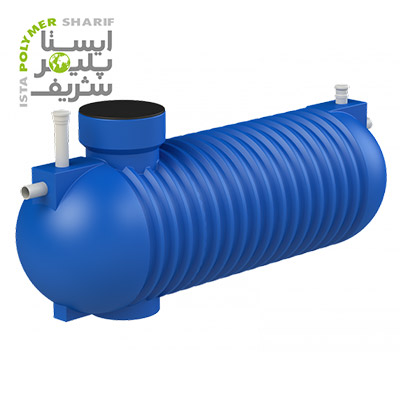Nowadays, polyethylene tanks are widely used in various applications, particularly in the water and wastewater industry. Polyethylene septic tanks are designed and manufactured according to the needs of commercial, administrative, and residential complexes. These tanks can be produced and constructed on-site as a single unit. Polyethylene septic tanks are highly utilized in the water and wastewater industries due to their high mechanical and chemical resistance. Additionally, polyethylene septic tanks are significantly more cost-effective compared to other materials, which, combined with their high mechanical properties, makes them widely used.
Design of Polyethylene Septic Tank
Polyethylene septic tanks are designed and manufactured using welding and rotomolding methods. Rotomolding has size limitations, whereas welding methods do not. Rotomolded tanks are designed and constructed up to a maximum volume of 5 cubic meters and do not meet potable water tank approval requirements. Polyethylene septic tanks are produced by welding polyethylene sheets or corrugated pipes (core tubes). Tanks made from pipe conversions are also suitable for burial. Polyethylene septic tanks have a high-strength wall that separates heavy wastewater from light wastewater. Polyethylene septic tanks are a strong competitor to composite and metal tanks in the wastewater industry.
Advantages of Polyethylene Septic Tanks
- Resistant walls that allow them to be buried without additional structures.
- Chemically resistant.
- Easy to set up and install.
- UV resistant from both inside and outside.
- Ready to install.
- Permanent treatment and separation.
- Corrosion resistant.
- No need for installation equipment.
- Low cost due to the absence of electromechanical equipment.
Two-Compartment Septic Tank
A two-compartment system differs from a single-compartment one in its collection method. As seen in the picture, the second compartment stores more liquids. In a separate tank, one compartment holds all the liquid, sludge, and scum. Adding a second compartment collects more sludge and liquid than the first compartment. Typically, two compartments are separated by a partition. When the partition opens, it allows a chosen amount of liquid to flow into the secondary area. When the liquids in the septic tank reach the height of the opening, the flow begins into the second compartment.
A two-compartment septic tank allows solids more time to settle, providing additional storage space for septic waste. Unlike a single-compartment septic tank, the extra compartment offers more space and more time before the tank needs to be emptied.
Applications of Polyethylene Septic Tanks
Composite and polyethylene septic tanks are generally not used in villages and cities, but their use helps settle solid materials in wastewater, preventing clogs in wastewater pipes. Given their advantages and features, polyethylene septic tanks have various applications, including:
- Preliminary treatment of large wastewater volumes
- Treatment of residential and commercial wastewater
- Preventing heat transfer from walls
- Balancing wastewater
Septic tanks are produced in both horizontal and vertical configurations and come in single-layer, three-layer, and four-layer options.




